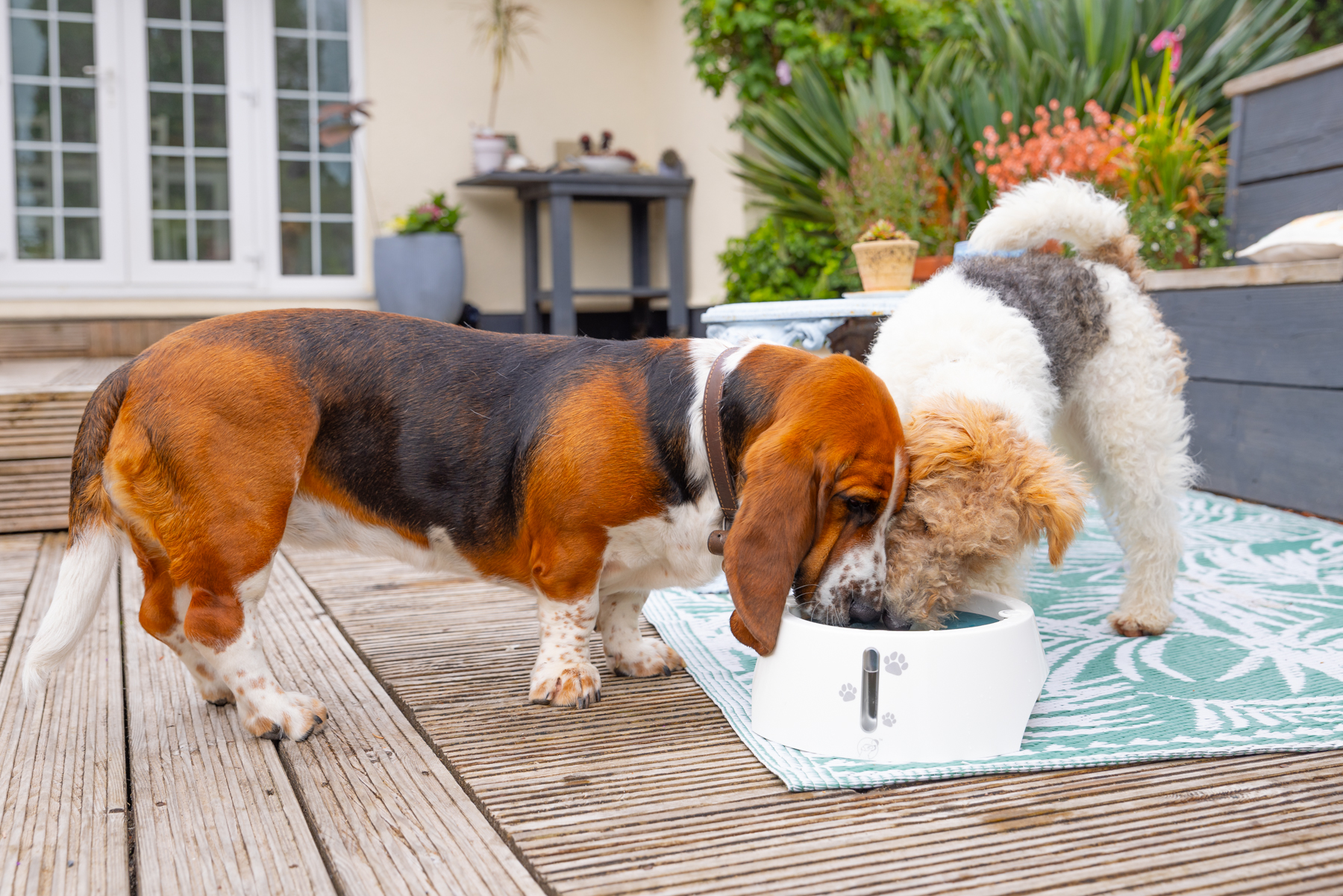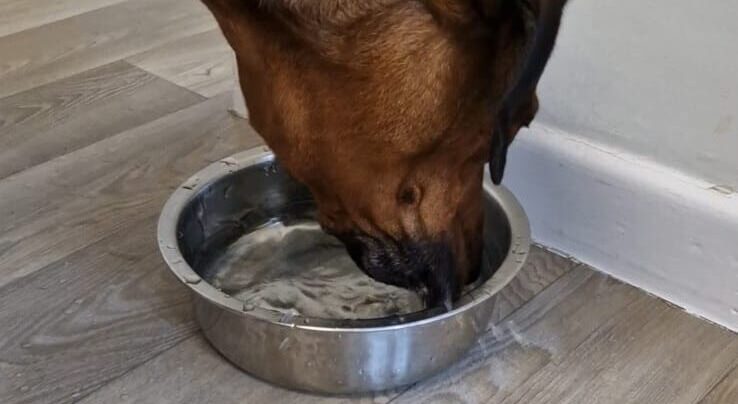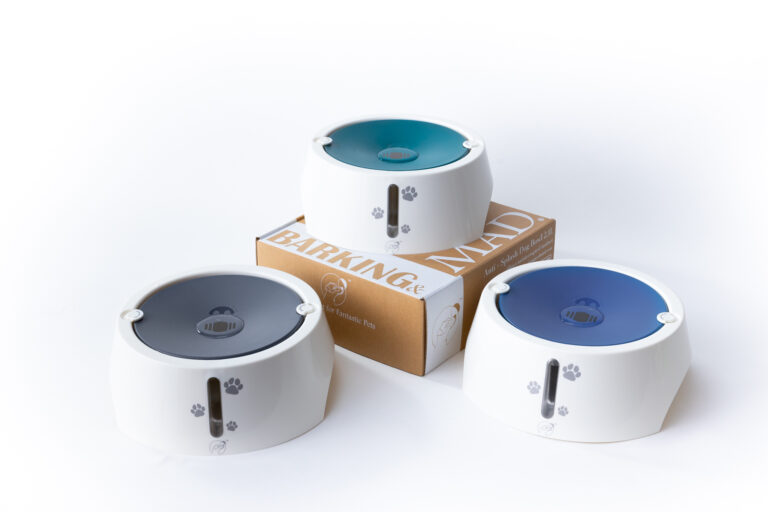Have you noticed your dog hovering around the water bowl drinking more than usual? It’s something that catches many dog owners off guard and raises the question: Why is my dog drinking so much water? I know I have! Ellie the family dog is probably the most thirsty, healthy dog I have ever met! She drinks what seems like an excessive amount every day, and is very messy when doing so – dribbling and splashing all over the floor.
Whether it’s on a hot summer day, after a long walk or sometimes for no reason at all, excessive thirst in dogs – also known as polydipsia – can be a concern. If you’re wondering why your dog is drinking so much water you’re not alone.
While some drinking habits are normal especially during increased activity or warm weather (in Ellies case) there can be underlying causes for sudden changes in water intake.
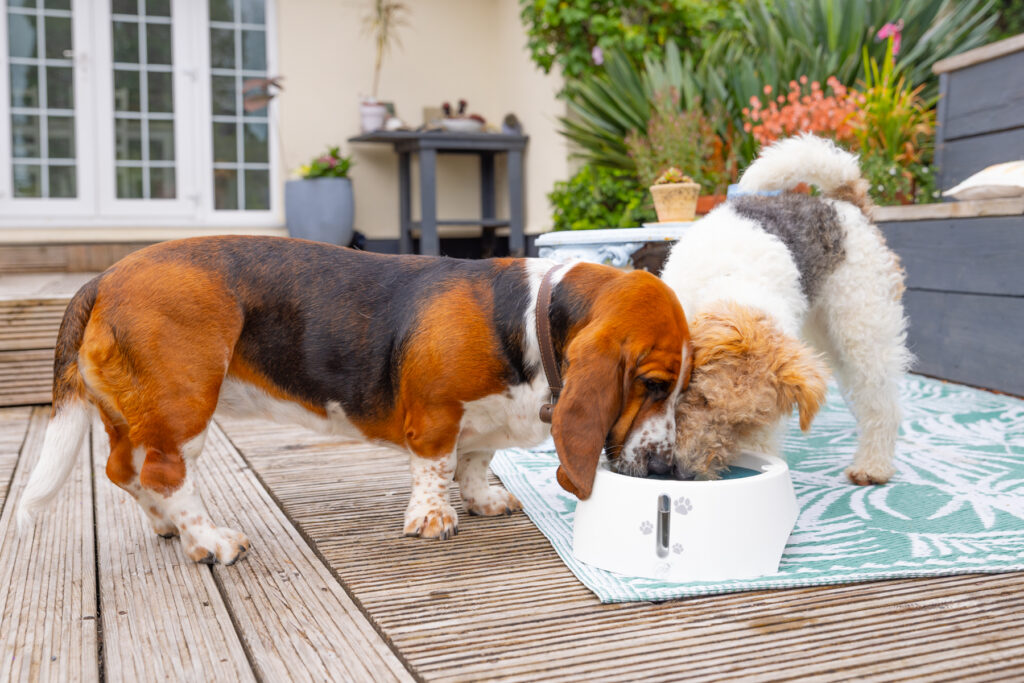
How Much Water Should Your Dog Drink Per Day?
As a dog owner you’ve probably asked yourself, “How much water should my dog drink each day?” It’s a good question especially when you’re concerned about excessive water intake. On average, dogs should drink about one ounce of water per pound of body weight per day. So if you have a 50 pound dog they should be drinking about 50 ounces (or about 6 cups) of water a day.
But, not all dogs are the same. Several factors including age, your dog’s diet, activity level and even the weather can affect a dog’s hydration needs. For example:
Active dogs or dogs that get excessive exercise will naturally drink more water after a long walk or a game of fetch. Think of it like how we humans feel after a workout. Their bodies need more hydration to replenish lost fluids.
Dogs on dry food will drink more than dogs on wet food diets. Dry kibble doesn’t provide the same hydration as canned food so your dog will need to be drinking a lot more water.
Puppies and nursing dogs need more water as their bodies are growing or supporting the growth of their pups.
In hot weather dogs will drink more to cool down especially if they’re panting or have been active.
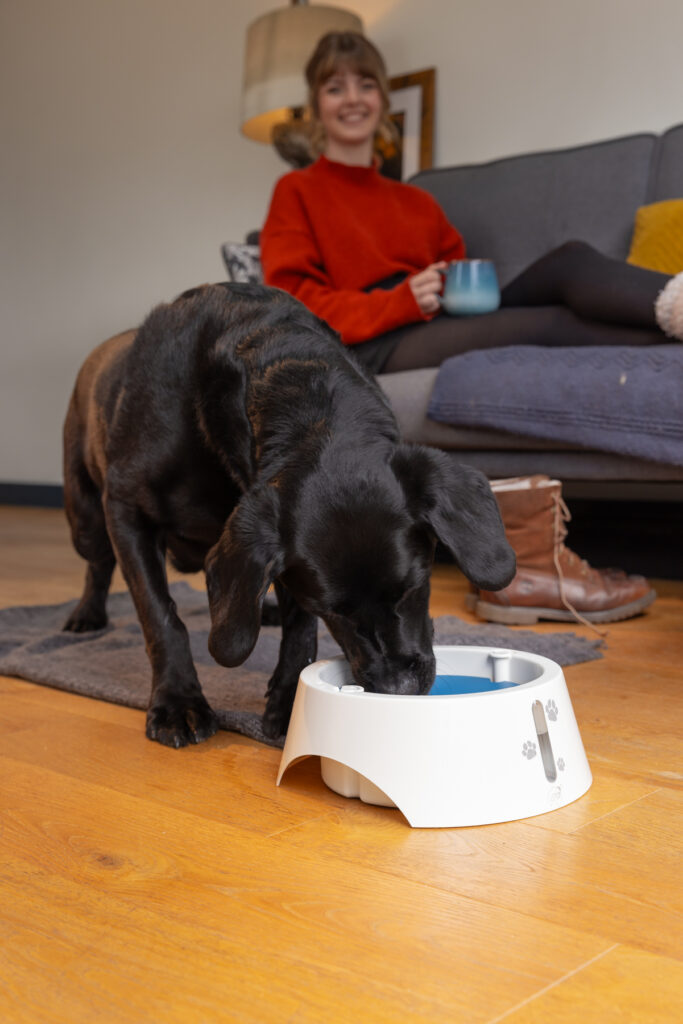
We’ve made this easy by putting water level indicators on our first product to the market, our splashing reducing dog bowl!
Why Is My Dog Drinking Too Much Water?
1. Diet and Dehydration
The most obvious and simplest reason for increased thirst in dogs is diet. Dogs on dry food need more water than dogs on wet food or raw diet. Dry food doesn’t provide the same level of hydration as canned food so your dog will drink more.
Salty meals or snacks can also increase your dog’s water intake. It’s okay for your dog to drink more after a salty meal but consistent excessive drinking could mean there’s an issue with their body weight or overall health.
2. Excessive Exercise
Dogs love to play especially very active dogs. Whether it’s a jog in the park or hours of chasing a ball they’ll naturally need more water after. But if your dog is drinking too much water even when not active it’s time to look for other reasons.

3. Age-Related Changes
As dogs age their bodies go through many changes. Senior dogs may need more water due to decreased kidney function or simply because their physical examination reveals other underlying issues such as kidney disease. A senior dog will drink more as their kidney function declines and they can’t concentrate their urine as well.
4. Underlying Health Conditions
Excessive thirst can be a sign of a more serious underlying health condition. Diabetes mellitus, kidney disease, liver disease or even Cushing’s disease can all present as increased thirst and excessive urination. These conditions cause the body to lose fluids so dogs will drink more water to compensate. Older dogs may be more susceptible to these health conditions.
For example in diabetes mellitus excess blood sugar can cause dehydration and the dog will drink and urinate more. Cushing’s disease which affects the adrenal glands often causes increased water intake and thirst.
If your dog’s water intake has gone up a visit to the vet is a must. A complete blood count, urine sample and physical examination can help determine if your dog’s thirst is related to an underlying health issue.
5. Medications and Treatments
Some medications like anti-seizure medications can cause increased thirst as a side effect. If your dog is on any medication check with your vet if this could be the reason for their excessive drinking.
The Balance: Don’t Restrict Water Intake
If your dog is drinking more than usual you might be tempted to restrict their access to water to prevent accidents or spills. But limiting a dog’s water intake is generally not recommended unless advised by a vet. Dogs need plenty of water to stay hydrated and support their bodily functions especially if they’re drinking to combat a condition that’s affecting their hydration levels.
The water level indicator lets you keep track of how much your dog is drinking while the BPA-free, UV-protected material is safe for indoor and outdoor use. Plus it’s dishwasher safe so cleaning is easy for you. What’s not to love!
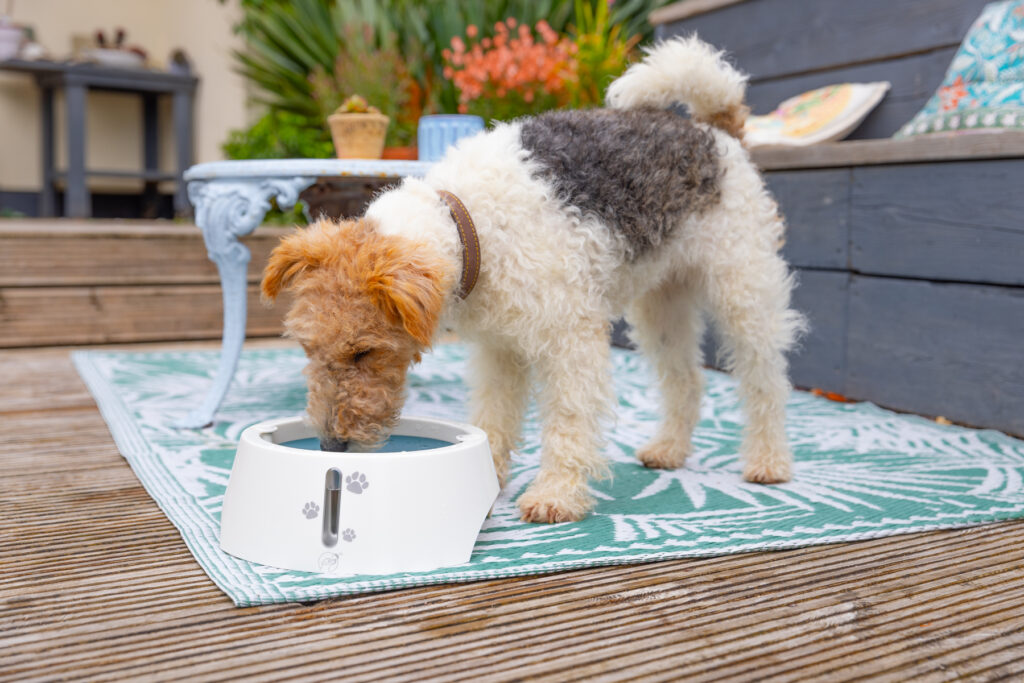
When to Take Your Dog to the Vet
While it’s normal for a dog to drink more on hot summer days or after a long play session, there are times when excessive drinking can be the underlying cause of something more serious. As pet owners we’re attuned to our dog’s habits and routines so a sudden change in drinking habits is worth investigating.
Here are some signs to watch out for:
1. Excessive Thirst and Urination
If your dog is drinking lots of water and urinating more than usual it could be a sign of an underlying condition such as kidney disease, diabetes mellitus or Cushing’s disease.
These conditions affect the body’s ability to retain fluids so your dog will drink and urinate more. Dogs with Cushing’s disease often develop a pot belly appearance and thin skin – other signs to look out for.
2. Changes in your Dog’s Appetite
Increase in water intake with changes in appetite is another red flag. If your dog is not interested in food or is gaining weight too fast contact your vet for an evaluation.
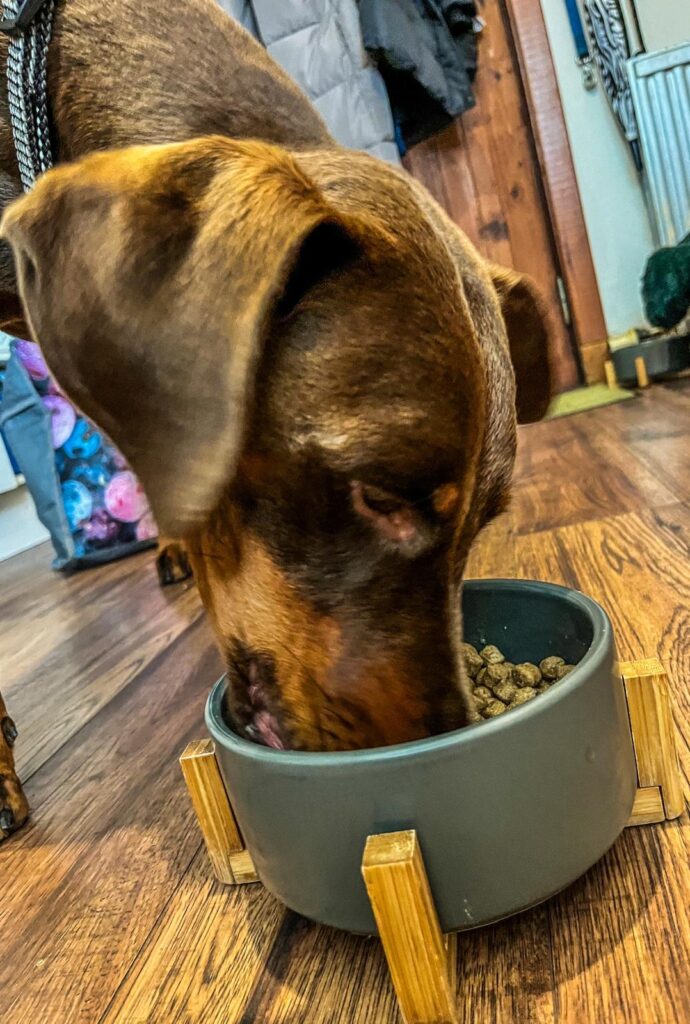
Dogs on dry food will drink more than dogs on wet food diets
3. Vomiting, Diarrhoea or Lethargy
Excessive drinking followed by vomiting, diarrhoea or lethargy could be a life threatening condition like severe kidney failure. If your dog is tired, sluggish or showing other symptoms like excessive panting or increased urination they may be dehydrated but more than that.
4. Visible Changes
Watch your dog’s coat and skin. If their fur looks dull or their skin is dry or less elastic (a sign of dehydration) it’s time to have your dog checked.
5. Sudden Onset of Drinking
If your dog has suddenly started drinking excessive amounts of water with no apparent reason (no increase in exercise or change in diet) it’s time to have them checked.
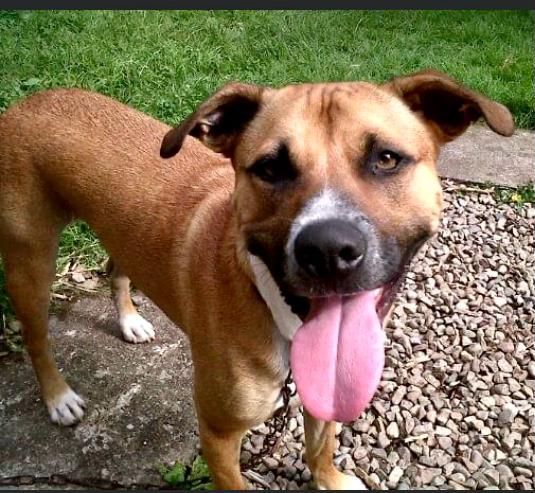
Still Have Questions? The FAQ!
Sudden increase in thirst could be due to underlying conditions like diabetes, kidney issues or stress.
Dogs need about one ounce of water per pound of body weight per day. Drinking more than that is an issue.
Yes, senior dogs may drink more due to conditions like kidney disease or Cushing’s disease that makes it harder for their body to retain water.
Increased drinking and urination could be a sign of diabetes, kidney disease or other metabolic disorders.
Never limit your dog’s water intake without consulting a vet. Dogs need proper hydration especially if they are drinking excessively.
You can slow down fast drinkers by using special bowls that control the flow of water like our Splash-Reducing Water Bowl which prevents splashing and gulping.
Yes, dogs may drink more water when anxious or stressed.
You can use our water bowl with a water level indicator or measure out your dog’s water each day to track their consumption. This will help you notice any changes in their drinking habits.
Conclusion
Knowing your dog’s water intake is key to keeping them healthy and hydrated. While dogs drink more on hot days or after exercise, a sudden increase in water intake is a red flag. Knowing how much water your dog should be drinking daily and being aware of changes in their behavior will help you catch potential health issues early.
If your dog is drinking a lot and has other symptoms like excessive urination or change in appetite, consult your vet. And, of course, make life easier with a splash-reducing water bowl that keeps your floors dry and monitors how much your dog drinks.
Your dog’s health and happiness is worth every drop.

